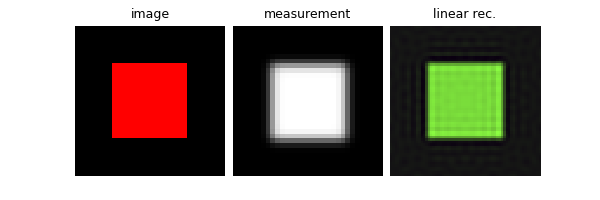Note
Go to the end to download the full example code.
Stacking and concatenating forward operators.
In this example, we show how to stack and concatenate forward operators to create new operators. In particular, we create a pan-sharpening operator by stacking a downsampling and a color-to-grayscale operators.
import deepinv as dinv
import torch
Stacking forward operators.
We can define a new forward operator by stacking or concatenating existing operators. Mathematically, this is equivalent to obtaining
Here we show how to stack two operators, one that downsamples a color image and another that converts the color image
grayscale. This is equivalent to the deepinv.physics.Pansharpen operator.
img_size = (3, 64, 64)
factor = 2
filter = "gaussian"
device = dinv.utils.get_freer_gpu() if torch.cuda.is_available() else "cpu"
physics1 = dinv.physics.Downsampling(
img_size=img_size, factor=factor, filter=filter, device=device
)
physics2 = dinv.physics.Decolorize(device=device)
physics_stacked = physics2 + physics1
Generate toy image
This example uses a toy image with 3 color channels.
The measurements of a stacked operator are deepinv.utils.TensorList objects, which are lists of tensors
that can be added, multiplied, etc. to other deepinv.utils.TensorList objects. It is also possible to
generate random or zero-filled deepinv.utils.TensorList objects in one line of code (similarly to standard
torch.Tensor).

Verifying the stacked operator
If the operator is linear, it is recommended to verify that the transpose well-defined using
deepinv.physics.LinearPhysics.adjointness_test(),
and that it has a unit norm using deepinv.physics.LinearPhysics.compute_norm().
Power iteration converged at iteration 22, value=0.68
The stacked operator has norm=0.68
The stacked operator has a well defined transpose
Concatenating forward operators.
It is also possible to concatenate operators using the * operator between two forward operators.
Here we create a new operator that first downsamples the image, and then converts it to grayscale.

Verifying the concatenated operator
Power iteration converged at iteration 9, value=0.11
The concatenated operator has norm=0.11
The concatenated operator has a well defined transpose
Total running time of the script: (0 minutes 0.372 seconds)